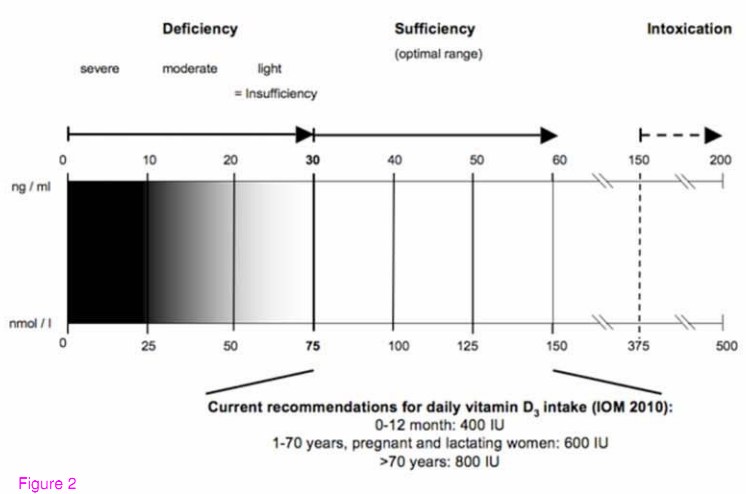Overview Women and Vitamin D
Lack of vitamin D causes problems throughout a woman's entire life

Columns from chart (from paper on this page)-for translation and links to more information
{SPLIT(colsize=190|235|220)}
Childhood
Type I diabetes
Rickets items
See related in VitaminDWiki
Pregnancy (see Pregnancy)
Caesarean section rate
PCOS
Birth weight down
Bone health items
Adulthood
Type II diabetes
Seniority
Menopause delayed and symptoms decreased by Vitamin D - many studies
{SPLIT}
See also VitaminDWiki
ALL of the top 10 health problems of women are associated with low vitamin D
The women who most need vitamin D are the least to get it – thesis March 2013
Women and vitamin D items
Hypothesis: women live longer because of vitamin D – Oct 2011
PMS: 1.5X more likely to have cramps, feel fatigued and anxious if low vitamin D – Sept 2018
Irregular menstrual cycles associated with low vitamin D – March 2015
Sublingual vitamin D – technical 2008 suspect that sublingual is similar to vaginal absorption
Less risk of pelvic floor disorders when vitamin D greater than 30 ng– April 2010
Uterine fibroids (hysterectomy) 32 percent more likely if less than 20 ng vitamin D – May 2013
Pelvic flood disorder strongly associated with lower vitamin D – March 2012
Clinical Trial vitamin D levels and IVF success – May 2011 with lots of links
Women category has the following
{include}
Vitamin D - roles in women's reproductive health - Nov 2011
Magdalena Grundmann Grundmann.magdalena@mh-hannover.de ; and Frauke von Versen-Hoeynck
Department of Obstetrics, Gynecology and Reproductive Medicine, Hannover Medical School, Carl-Neuberg-Strasse 1, 30625 Hannover, Germany
Reproductive Biology and Endocrinology 2011, 9:146 doi:10.1186/1477-7827-9-146
In the past few years a growing interest in vitamin D can be observed in the lay and biomedical literature due to findings demonstrating a low vitamin D status in the population. In addition to its importance for the regulation of calcium and phosphorus homeostasis recent epidemiologic studies have observed relationships between low vitamin D levels and multiple disease states. This secosteroid hormone also regulates the expression of a large number of genes in reproductive tissues implicating a role for vitamin D in female reproduction. In this report we summarize the recent evidence that vitamin D status influences female reproductive and pregnancy outcomes. Human and animal data suggest that low vitamin D status is associated with impaired fertility, endometriosis and polycystic ovary syndrome. Evidence from observational studies shows higher rates of preeclampsia, preterm birth, bacterial vaginosis and gestational diabetes in women with low vitamin D levels. However, confirmation of experimental observations establishing an association of vitamin D deficiency with adverse reproductive outcomes by high quality observational and large-scale randomized clinical trials is still lacking. The determination of optimal 25(OH)D3 levels in the reproductive period and the amount of vitamin D supplementation required to achieve those levels for the numerous actions of vitamin D throughout a woman's life would have important public health implications.
CLICK HERE for full text for translation of preliminary version to other languages
[tiki-downloadfile.php?fileId=2004], [tiki-downloadfile.php?fileId=2070]
Nice summary of vitamin D levels from this paper

Interesting way of showing non-classical influences of vitamin D

Sufficiency is 30-60 ng, optimal 50-80 ng,toxicity does not start until 150 ng
==
The Costs of Motherhood Are Rising, and Catching Women Off Guard NY Times Aug 2018
"Since about 1985, no more than 2 percent of female high school seniors said they planned to be “homemakers” at age 30, even though most planned to be mothers. The surveys also found no decline in overall job satisfaction post-baby. Yet consistently, between 15 percent and 18 percent of women have stayed home"
"The cost of motherhood fell for most of the 20th century because of inventions like dishwashers, formula and the birth control pill. But that’s no longer the case, according to data cited in the paper. The cost of child care has increased by 65 percent since the early 1980s. Eighty percent of women breast-feed, up from about half. "
